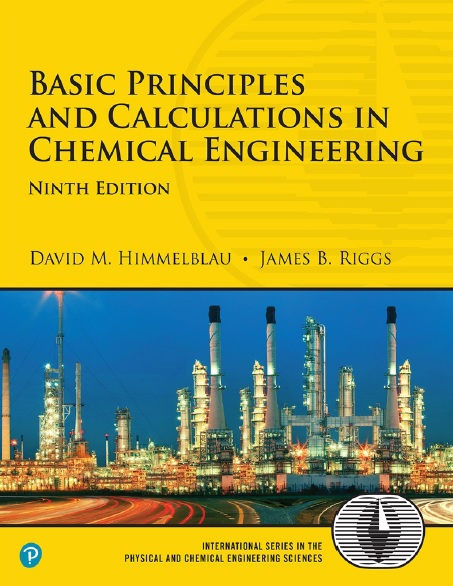Basic Principles and Calculations in Chemical Engineering, Ninth Edition
By David M. Himmelblau and James B. Riggs

Contents:
Preface
How To Use This Book
Acknowledgments
About The Authors
Part I Introduction
CHAPTER 1 INTRODUCTION TO CHEMICAL ENGINEERING
1.1 A Brief History of Chemical Engineering
1.2 Types of Jobs Chemical Engineers Perform
1.3 Industries in Which Chemical Engineers Work
1.4 Sustainability
1.5 Ethics
CHAPTER 2 INTRODUCTORY CONCEPTS
2.1 Units of Measure
2.2 Unit Conversions
2.3 Equations and Units
2.4 Measurement Errors and Significant Figures
2.5 Validation of Results
2.6 Mass, Moles, and Density
2.7 Process Variables
PART II MATERIAL BALANCES
CHAPTER 3 MATERIAL BALANCES
3.1 The Connection between a Process and Its Schematic
3.2 Introduction to Material Balances
3.3 A General Strategy for Solving Material Balance Problems
3.4 Material Balances for Single Unit Systems
3.5 Vectors and Matrices
3.6 Solving Systems of Linear Equations with MATLAB
3.7 Solving Systems of Linear Equations with Python
CHAPTER 4 MATERIAL BALANCES WITH CHEMICAL REACTION
4.1 Stoichiometry
4.2 Terminology for Reaction Systems
4.3 Species Mole Balances
4.4 Element Material Balances
4.5 Material Balances for Combustion Systems
CHAPTER 5 MATERIAL BALANCES FOR MULTIUNIT PROCESSES
5.1 Preliminary Concepts
5.2 Sequential Multiunit Systems
5.3 Recycle Systems
5.4 Bypass and Purge
5.5 The Industrial Application of Material Balances
PART III GASES, VAPORS, AND LIQUIDS
CHAPTER 6 IDEAL AND REAL GASES
6.1 Ideal Gases
6.2 Real Gases: Equations of State
6.3 Real Gases: Compressibility Charts
6.4 Real Gas Mixtures
CHAPTER 7 MULTIPHASE EQUILIBRIUM
7.1 Introduction
7.2 Phase Diagrams and the Phase Rule
7.3 Single-Component Two-Phase Systems (Vapor Pressure)
7.4 Two-Component Gas/Single-Component Liquid Systems
7.5 Two-Component Gas/Two-Component Liquid Systems
7.6 Multicomponent Vapor-Liquid Equilibrium
PART IV ENERGY BALANCES
CHAPTER 8 ENERGY BALANCES WITHOUT REACTION
8.1 Terminology Associated with Energy Balances
8.2 Overview of Types of Energy and Energy Balances
8.3 Energy Balances for Closed, Unsteady-State Systems
8.4 Energy Balances for Open, Steady-State Systems
8.5 Mechanical Energy Balances
8.6 Energy Balances for Special Cases
CHAPTER 9 ENERGY BALANCES WITH REACTION
9.1 The Standard Heat (Enthalpy) of Formation
9.2 The Heat (Enthalpy) of Reaction
9.3 Integration of Heat of Formation and Sensible Heat
9.4 The Heat (Enthalpy) of Combustion
PART V COMBINED MATERIAL AND ENERGY BALANCES
CHAPTER 10 HUMIDITY (PSYCHROMETRIC) CHARTS
10.1 Terminology
10.2 The Humidity (Psychrometric) Chart
10.3 Applications of the Humidity Chart
CHAPTER 11 UNSTEADY-STATE MATERIAL AND ENERGY BALANCES
11.1 Unsteady-State Balances
11.2 Numerical Integration of ODEs
11.3 Examples
Chapter 12 Heats Of Solution And Mixing
Chapter 13 Liquids And Gases In Equilibrium With Solids
Chapter 14 Solving Material And Energy Balances Using
Process Simulators (Flowsheeting Codes)
Part Vi Supplementary Material
Appendixes
A Atomic Weights And Numbers
B Tables Of The Pitzer Z0 And Z1 Factors
C Heats Of Formation And Combustion
D Answers To Selected Problems
E Physical Properties Of Various Organic And Inorganic Substances
F Heat Capacity Equations
G Vapor Pressures
H Heats Of Solution And Dilution
I Enthalpy-Concentration Data
K Physical Properties Of Petroleum Fractions
L Solution Of Sets Of Equations
M Fitting Functions To Data
Index
